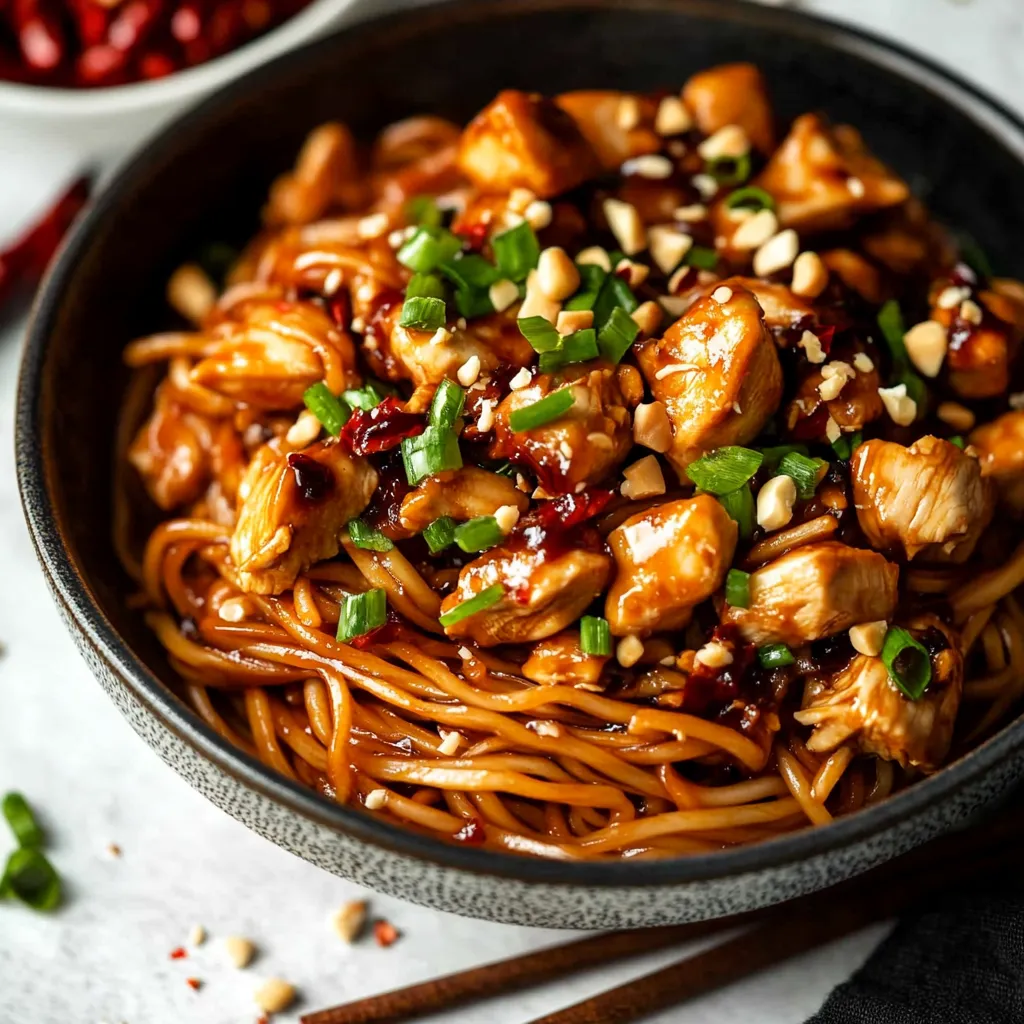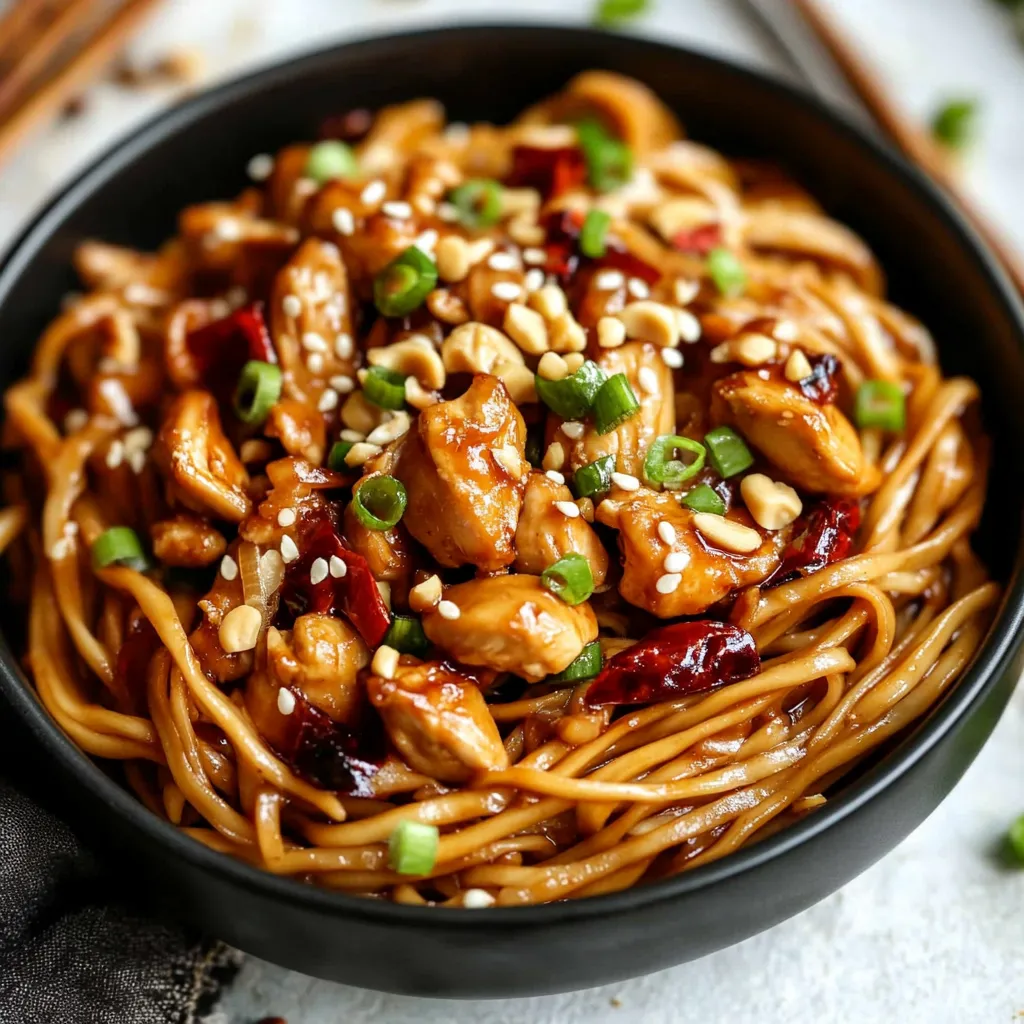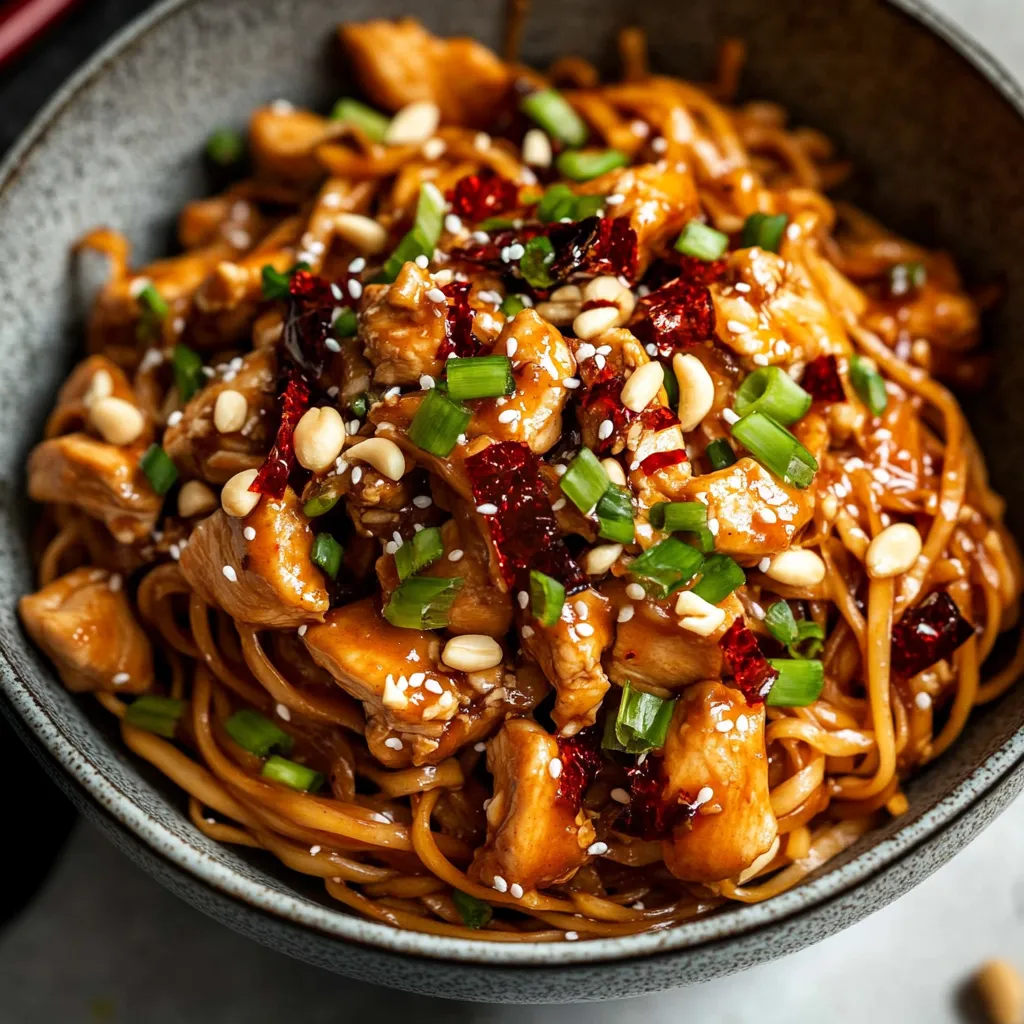 Pin it
Pin it
Kung Pao Chicken Noodles bring together the classic sweet savory and spicy flavors of Szechuan cuisine into a slurpy noodle bowl that is irresistible on a weeknight. This dish started as a craving for takeout but quickly became my homemade favorite packed with tender chicken and a punchy sauce that never fails to impress my family.
I made this dish for my husband on a busy night and he claimed it rivals our favorite neighborhood noodle house. Now we make it together whenever we want a quick flavor packed meal without leaving home.
Ingredients
- Noodles of choice: help soak up the Kung Pao sauce choose fresh or dried for the best texture
- Chicken breast: provides lean protein and cooks up tender when marinated
- Low sodium tamari or soy sauce: brings umami and saltiness opt for a high quality brand
- Honey: adds just enough sweetness to balance the chili paste
- Chili paste: gives signature heat and depth try sambal oelek for bright flavor
- Toasted sesame oil: deepens the nutty aroma buy pure toasted oil not blended
- Green onion: adds a fresh bite use mostly the white for cooking and green for garnish
- Minced garlic: infuses the oil with rich taste use fresh cloves for sharpest flavor
- Peanut butter: makes the sauce creamy and rich smooth works best
- Rice vinegar: adds brightness and balances the sauce
- Brown sugar: bumps up sweetness adjust to your preference
- Ground ginger: brings a gentle spice keep ground ginger fresh for best results
- Red pepper flakes: add even more heat or leave out for a milder version
- Cornstarch: thickens the sauce to glossy perfection
- Crushed peanuts: offer nutty crunch on top choose dry roasted for boldest flavor
Step-by-Step Instructions
- Marinate the Chicken:
- Cut the chicken breast into one inch pieces and place them in a bowl. Add the tamari or soy sauce honey and chili paste and toss until fully coated. Cover and marinate in the refrigerator for up to two hours but even thirty minutes gives great flavor.
- Cook the Noodles:
- Bring a generous pot of salted water to a boil and cook your noodles according to the package for your preferred doneness. Drain and set aside in a large bowl drizzling a bit of sesame oil to prevent sticking.
- Make the Sauce:
- In a separate mixing bowl whisk together tamari or soy sauce peanut butter rice vinegar chili paste brown sugar ground ginger sesame oil and red pepper flakes. In a small cup blend water and cornstarch until smooth but do not add yet.
- Cook Aromatics and Chicken:
- Heat toasted sesame oil in a large skillet over medium low heat. Add diced white part of green onion and cook until slightly softened and fragrant about two to three minutes. Stir in minced garlic and cook for another minute until golden but not burnt. Increase heat to medium and add the marinated chicken pieces discarding the leftover marinade. Sauté the chicken on all sides until golden and cooked through to an internal temperature of one hundred sixty five degrees Fahrenheit about three to four minutes per side.
- Thicken Sauce and Combine:
- Pour the prepared sauce mixture into a small saucepan and bring to a simmer over gentle heat. Whisk in the cornstarch slurry and let the sauce thicken until glossy. Add the cooked noodles to the thickened sauce and toss until thoroughly coated.
- Mix It All Together:
- Return the cooked chicken to the pan with the noodles and sauce. Use tongs or two large spoons to mix everything so the flavors meld. Cook for a minute or two just to blend.
- Garnish and Serve:
- Transfer the noodles to serving bowls. Scatter with crushed peanuts and green onion greens. Serve piping hot as is or with steamed vegetables for extra crunch.
 Pin it
Pin it
I have a real soft spot for the crushed peanuts on top they add crunch and nostalgia because as a kid I used to sneak handfuls of peanuts when my grandmother made her signature Kung Pao dish. Every bite now brings back those kitchen memories and laughter around the table.
Storage Tips
Kung Pao Chicken Noodles are ideal for meal prep. They keep fresh in an airtight container in the refrigerator for up to three days and the flavors deepen overnight. To reheat gently warm in a skillet with a splash of water or extra sauce to keep the noodles tender. Avoid microwaving with peanuts as they can soften.
Ingredient Substitutions
You can swap chicken for shrimp or even tofu for a vegetarian spin. Use soba or rice noodles for a gluten free version. Almond butter works in place of peanut butter if you need a nut free alternative just swap the peanut garnish for toasted seeds.
Serving Suggestions
Serve these noodles with lightly steamed broccoli snow peas or bell peppers for a vegetable boost. For a full Szechuan spread pair with pickled cucumber salad or kimchi and a simple egg drop soup. Leftovers can be packed in a thermos for a satisfying next day lunch.
Cultural and Historical Context
Kung Pao is inspired by the classic Chinese Kung Pao chicken which originated in the Sichuan province known for bold spicy flavors. This noodle adaptation brings the spirit of street food carts and busy noodle shops to a home kitchen infusing each bite with a balance of sweetness tang and warmth.
 Pin it
Pin it
This bowl is slurpy soul soothing and sure to turn any night into a special meal even if you are just craving takeout flavors at home.
Frequently Asked Questions
- → What type of noodles work best?
Wheat, egg, or rice noodles are all great choices. Use your preferred type or what you have on hand.
- → How spicy is this dish?
It’s moderately spicy, but you can adjust the chili paste and red pepper flakes to your heat preference.
- → Can I use a different protein?
Absolutely! Tofu, shrimp, or thin steak strips also pair well with the sauce and noodles.
- → Are peanuts essential for this dish?
Peanuts add classic flavor and texture, but you can omit them or use cashews if there’s an allergy concern.
- → What vegetables go well in this dish?
Broccoli, bell peppers, snap peas, and carrots are all great additions for crunch and color.
